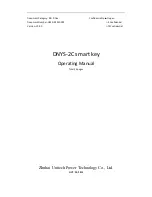
11
the patient programmer. If unpleasant sensations occur, the device should be
turned off immediately.
•
Stimulation Parameters –
Stimulation parameters must be determined under
the supervision of your physician. Do not adjust stimulation parameters within
prescribed programs unless ordered to do so by your physician.
• Transcranial Magnetic Stimulation (TMS) and Electroconvulsive Therapy
(ECT) –
Inform your doctor and medical personnel that safety has not been
established for TMS or ECT with your implanted neurostimulation system.
Induced electrical currents may cause heating, especially at the lead electrode
site, resulting in tissue damage.
•
Transcutaneous Electrical Nerve Stimulation –
Inform your doctor and
medical personnel that safety has not been established for transcutaneous
electrical nerve stimulation (TENS) electrodes and may cause TENS current to
pass over part of the neurostimulation system. If you feel that the TENS may be
interfering with the implanted neurostimulator, discontinue using the TENS until
you talk with your doctor.
•
Therapeutic Radiation –
Therapeutic radiation may damage the electronic
circuitry of an implanted neurostimulation system, although no testing has been
performed and no definite information on radiation effects is available. Sources
of therapeutic radiation include x-rays, cobalt machines, and linear accelerators.
If radiation therapy is required, the area over the implanted INS should be
shielded with lead.
•
Long-Term Effectiveness of DRG Stimulation –
The long-term effectiveness
of DRG stimulation has been documented. You may not realize long-term
benefits from DRG stimulation. Stimulation effectiveness has been established
for one year.
Adverse Events
The implantation of a neurostimulation system involves risk. In addition to those
risks commonly associated with surgery, the following risks are also associated with
implantation and use of the Axium Neurostimulator System:
• Pain (where the needle has been inserted)
• Pain (caused by understimulation due to lead migration)
• Pain over the implantable neurostimulator site
• Escalating pain
• Bleeding (where the needle has been inserted)
• Headache
• Infection
•
Localized collection of serous (clear) fluid at injection site
• Discomfort during the treatment
• Allergic or rejection response to implant materials
• Constant pain at the lead site
• Stimulation of the chest wall
• Lead migration (movement) and/or local skin breakage
• Weakness
Summary of Contents for Axium
Page 35: ......
















































